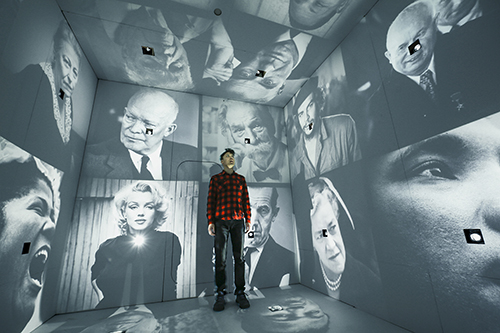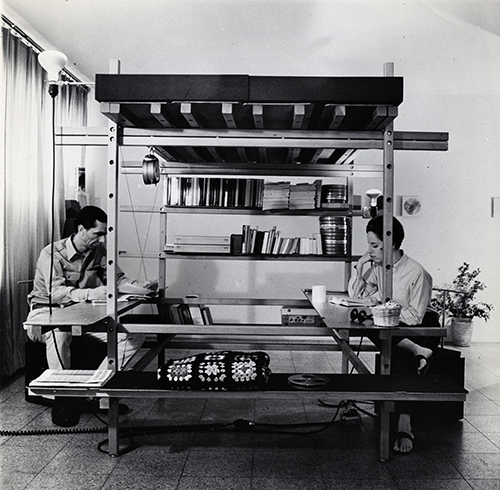
PHOTO BY GREG BECKEL, COURTESY WALKER ART CENTER, MINNEAPOLIS
Interior view of Ken Isaacs’s The Knowledge Box (1962/2009) in the exhibition Hippie Modernism: The Struggle for Utopia, 2015.

PAUL KRAINAK
In the fall of 1983, I co-organized a summer program at the Oxbow Artists Residency in Saugatuck, Mich., a historic center with old ties to the Chicago art community. My partner was Ken Isaacs, an architect and professor at the University of Illinois, Chicago. Isaacs, who I was only slightly familiar with at the time, was an early proponent of DIY aesthetics, a conscientious critic of high modernism and disapproving of the wasteful economics of building in the U.S.
Issacs organized the architectural component of the upcoming summer and we met a few times to get acquainted and see if there might be some thematic or organizational overlap. At our first corner diner meeting in Streeterville, I found him waiting at the counter. Though there were ample booths he preferred not to occupy more room than we needed. For Isaacs, I came to understand, all spaces were resources that ought not be exploited. A stool and countertop was all that was necessary for a chat. On one hand, it was just the civil way to behave in an urban environment. It was also commensurate with his history of attenuating the material excesses of the economy, rather than conforming to the privileged materialism of even the most progressive architecture of his time.
At our next meeting, he casually mentioned he had once been a guest on the Tonight Show with Johnny Carson. He wasn’t boasting, but making a point about the problem of exclusivity in the arts. Isaacs was the best kind of populist, convinced that seemingly radical ideas could flourish if wider audiences had access. In the ‘60s and early ’70s, talk shows weren’t just about middle-class blather. They were peppered with unpretentious people who walked a beat in various disciplines. Writers, architects, conductors, scientists, poets, film directors, chess players and politicians appeared alongside the glitterati, rather than deposited in niche venues like now. Popular culture in the ’50s and ’60s, even with severe cultural blind-spots, included a framework for reflecting the work of principal cultural specialists. It was a very brief heyday of the public intellectual.
Thanks to Chicago critic Susan Snodgrass, the further story of Ken Issacs has just been fleshed out in “Inside the Matrix: The Radical Designs of Ken Issacs.” It’s a narrative that follows the architect from his childhood in Groveland, Ill., to Bradley University, where he received a BFA in an interdisciplinary program of studio art, theater and industrial design. Later came graduate work at Cranbrook, a move to New York City and then Chicago, while maintaining his family property in Groveland and using it for experimental shelters and collaborative projects with his students.
Snodgrass explains the gradual development of Isaacs’ affordable, easily constructed and portable living structures, as well as the adaptation of design systems and structures reflecting his aspirations of a more egalitarian society. His construction matrix and innovative methods gained the attention of several nationally broadcast talk shows as well as Life and Look Magazine, Popular Mechanics, the New York Times and others. We read of his sparse upbringing, a child of an itinerant farmer in the midst of the depression, (which partially explains his appetite for assembling basic fixtures and tools for creative housing solutions), ones that accentuated financial independence, communalism and technological resourcefulness. This work, forecast by designs he started at Bradley, later integrated collage-based photo-technology, embraced a 1960s anti-establishment leitmotif, and contributed to counterintuitive visual and sound strategies for teaching. His experimentalism landed him international recognition and academic positions at Cranbrook, the Illinois Institute of Technology and the University of Illinois, Chicago.
Another factor that distinguished Isaacs from his contemporaries and from so many of today’s designers and artists is the degree his work was structured by a unified philosophy of creative production –– one with both a world view and a sensitivity to the immediate environment. As his living and educational structures were designed to be built by anyone anywhere, they facilitated a consciousness about the place one inhabited, again an aspect in synch with the culture of the 1960s –– utopianism and the initial stages of environmentalism. A 2015 interview by Snodgrass elicited this response about his perceptions of architecture and environmental crisis, “At some point, man must order his relationship to the physical environment toward harmonious coexistence rather than the short-term, mindless piracy of the planet that has marked his history to this point.”
Ken Isaacs died in June 2016 at age 88.

PHOTO COURTESY OF THE ESTATE OF KEN ISAACS
Ken Isaacs, Living Structure 6’ x 6’, c. 1961.
“Inside the Matrix, The Radical Designs of Ken Isaacs” Half Letter Press, PO Box 12588, Chicago, IL. 60612, www.halfletterpress.com
https://walkerart.org/magazine/enter-matrix-interview-ken-isaacs#_edn1

1 comment for “Inland Art | Inside the Matrix: The Radical Designs of Ken Isaacs”
Recent Comments
Paul this piece warms my heart. Having originally discovered Ken Isaacs’s book, “How to Build Your Own Living Structures,” courtesy of a review in the Whole Earth Catalog in the 1970’s…I am thrilled this Gentle Genus is still garnering attention. Especially with this thoughtful and revealing peace.
Copies of the noted book sell on Amazon used for as much as, $120.00 used with a new copy going for over $950.00. Might I suggest you start the rally Paul to ave the estate contact the original publisher Crown to bring out say a 40th Anniversary edition. With perhaps a couple of more Bonus extras included.
Let me know…I will buy the first copy.